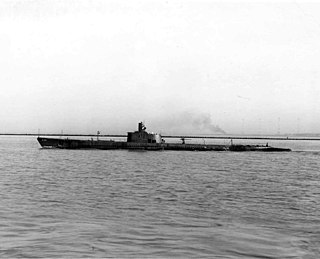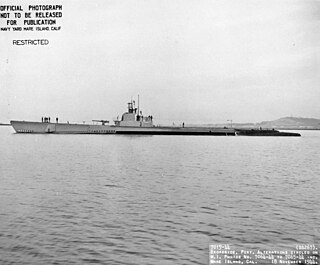
USS Tunny (SS/SSG/APSS/LPSS-282) was a Gato-class submarine which saw service in World War II and in the Vietnam War. Tunny received nine battle stars and two Presidential Unit Citations for her World War II service and five battle stars for her operations during the Vietnam War. Tunny was the first ship of the United States Navy to be named for the tunny, any of several oceanic fishes resembling the mackerel

USS Halibut (SS-232), a Gato-class submarine, was the first ship of the United States Navy to be named for the halibut, a large species of flatfish.

USS Whale (SS-239), a Gato-class submarine, was the second ship of the United States Navy to be named for a whale, an extremely large, aquatic mammal that is fishlike in form. The USS Cachalot (SS-170) commissioned on 1 December 1933 preceded the Whale.

USS Trout (SS-202) was the fifth Tambor-class submarine commissioned in the United States Navy, serving in the Pacific from 1941 to 1944. She received 11 battle stars for World War II service and Presidential Unit Citation for her second, third, and fifth war patrols. Trout also delivered ammunition to the besieged American forces on Corregidor and brought out 20 tons of gold bars and silver pesos from the Philippine currency reserve to Pearl Harbor. During 1941, she was used as a target by a series of tests determining the vulnerability of submarines to depth charge attacks.

USS Tullibee (SS-284), a Gato-class submarine, was the first ship of the United States Navy to be named for the tullibee. Her keel was laid down on 1 April 1942 at Mare Island, California, by the Mare Island Navy Yard. She was launched on 11 November 1942 sponsored by Mrs. Kenneth C. Hurd; and commissioned on 15 February 1943, Commander Charles Frederic Brindupke in command.

USS Snook (SS-279), a Gato-class submarine, was the first ship of the United States Navy to be named for the common snook, an Atlantic marine fish that is bluish-gray above and silvery below a black lateral line.

USS Silversides (SS/AGSS-236) is a Gato-class submarine, the first ship of the United States Navy to be named for the silversides.

USS Drum (SS-228) is a Gato-class submarine of the United States Navy, the first Navy ship named after the drum, a type of fish. Drum is a museum ship in Mobile, Alabama, at Battleship Memorial Park.

USS Tarpon (SS-175), second United States Navy ship of this name, was a Porpoise-class diesel-electric submarine. Tarpon conducted war patrols in the Pacific Ocean during World War II.

USS Pollack (SS-180), a Porpoise-class submarine, was the first ship of the United States Navy to be named for the pollack, a food fish resembling the true cod, but with the lower jaw projecting and without the barbel.

USS Snapper (SS-185), a Salmon-class submarine, was the third ship of the United States Navy of the name and the second to be named for the snapper.

USS Greenling (SS-213), a Gato-class submarine, was the first ship of the United States Navy to be named for the greenling.

USS Flying Fish (SS/AGSS-229), a Gato-class submarine, was the first submarine and second ship of the United States Navy to be named for the flying fish. Flying Fish is credited with having sunk a total of 58,306 tons of Japanese shipping and received 12 battle stars for World War II service.

USS Haddock (SS-231), a Gato-class submarine, was the second submarine of the United States Navy to be named for the haddock, a small edible Atlantic fish related to the cod. A previous submarine had been named Haddock (SS-32), but was renamed K-1 prior to her launching, so Haddock (SS-231) was the first to actually bear the name.

USS Peto (SS-265), a Gato-class submarine, was a ship of the United States Navy named for the peto, a sharp-nosed tropical fish of the mackerel family.

USS Pogy (SS-266), a Gato-class submarine, was the first ship of the United States Navy to be named for the pogy, or menhaden. She was credited with sinking 16 ships totaling 62,633 gross register tons during World War II.

USS Pompon (SS/SSR-267), a Gato-class submarine, was a ship of the United States Navy named for the pompon, an American fish of the Anisot family.

The first USS Sunfish (SS-281), a Gato-class submarine, was the first ship of the United States Navy to be named for the ocean sunfish, Mola mola, a plectognath marine fish, having a deep body truncated behind, and high dorsal and anal fins.
USS Tinosa (SS-283), a Gato-class submarine, was the first ship of the United States Navy to be named for the tinosa.

USS Seahorse (SS-304), a Balao-class submarine, was the first submarine and second ship of the United States Navy to be named for the seahorse, a small fish whose head and the fore part of its body suggest the head and neck of a horse.





















